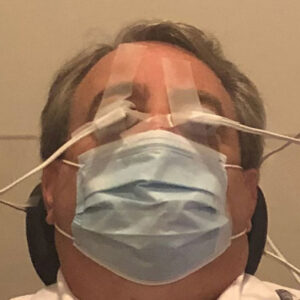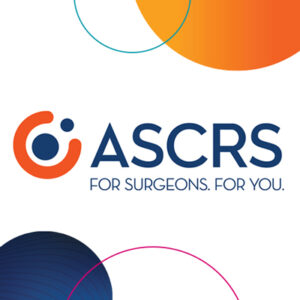In Other News
April 2015
by Lauren Lipuma
EyeWorld Staff Writer
Ophthalmologist pushes the limits of personal achievement
2015 marks a special anniversary for Bala Ambati, MD, PhD, professor and director of cornea research, Moran Eye Center, University of Utah, Salt Lake City. Next month, it will be 20 years since he graduated from medical school and became a practicing physician. This may not be a particularly noteworthy milestone for most physicians, but for Dr. Ambati, it is more significant—he is only 37.
Graduating from high school at age 11, college at 13, and medical school at 17, in 1995 Dr. Ambati became the record holder for the world’s youngest doctor. It is a distinction he still holds to this day, 20 years later.

Naturally, being the world’s youngest doctor has brought him a steady stream of media attention. He’s been called a whiz kid, a boy prodigy, a medical academic superman, and a real-life Doogie Howser. Newspaper articles have claimed that he was doing calculus at age 4.
In personality, Dr. Ambati barely resembles the typical idea of a child prodigy. Calm and humble, he says he feels blessed for all of the opportunities he has been given, and graduating from medical school at 17 is not his greatest achievement.
“My biggest accomplishment is taking the patch off the day after surgery every week and seeing people smile,” he said in an interview with EyeWorld. “That’s what makes me happiest, and that’s the best part of my week.”
School at lightning speed
Dr. Ambati immigrated to the U.S. from Vellore, India, when he was 3 years old, with his father, an engineering professor, his mother, a Tamil linguist and mathematician, and his older brother, Jaya.
The Ambati brothers began grade school at the normal age but raced through at an unprecedented pace. Jaya completed high school in 2 years and graduated from Johns Hopkins University at age 17, then went on to pursue a medical degree, specializing in ophthalmology.
Young Bala sped through grade school even faster than his brother. Skipping several grades, he completed elementary school in 2 years, middle school in 2 years, and high school in 2 years, graduating at age 11. The support of his family was instrumental in this process, Dr. Ambati said, but his parents did not pressure him to do more than he could.
“My pace in school was set by what I felt challenged and comfortable with,” he said. “If I had gone through the normal pathway, I think I would have been very bored and maybe gotten into trouble. I felt I was going at the right pace when it came to math and science and English and history, and doing the advanced subjects that I felt challenged by.”
The Ambati brothers’ interest in medicine became apparent in 1989, when they collaboratively wrote AIDS: The True Story: A Comprehensive Guide, a book aimed at educating high school and college students about the growing epidemic. When the book was published, Bala was just 11 and Jaya was 18.
“We had seen a lot of discrimination against AIDS patients, people’s houses being burned down and run out of town, things like that,” Dr. Ambati said. “We wanted to do something that would educate the younger generation … and dispel many of the myths and misconceptions around the disease.”
The book was a testament to the boys’ maturity—the brothers eloquently delved into the public health, sexuality, and social stigma issues associated with HIV with ease.
The brothers’ remarkable journey through school was not without obstacles, however. Dr. Ambati recalled that his parents had to fight vigorously with school administrators to allow him to skip grades, negotiating with school principals, superintendents, and even the mayor. “Administrators in public schools all too often embody inertia,” he said. “[They were] the main source of resistance, and it was resistance to doing something different, doing something out of the ordinary.”
Despite those challenges in grade school, college was more straightforward, Dr. Ambati said. He was accepted to several universities and chose to attend New York University. Having already taken several college courses—some before he was 10—he graduated in just 2 years at age 13, then continued on to medical school. During the application process, he again faced resistance—and even hostility—from school interviewers because of his age.
“I think there are understandable concerns about whether someone is mature enough for medical school, but each person matures differently with time,” he said. “So I think it’s best to look at each person as an individual and judge them on their own merits, rather than look at them by a particular number.”
Despite the opposition, Dr. Ambati does not begrudge any of the interviewers’ or the schools’ skepticism. “I applied to 9 medical schools and only got into 1, but hey, you only need 1, right?” he said. “Everything happened the way it was meant to. I got into 1 medical school, and it worked out well, and if I had to do things over again, I’d pretty much do them the same way.”

Source (all): Bala Ambati, MD, PhD
Medicine and beyond
Even with a record-setting pace in grade school and college, no one can fast-forward medical school. Dr. Ambati spent 4 years at Mount Sinai School of Medicine in New York, graduating in May 1995, just 2 months shy of his 18th birthday.
The last big hurdle he faced was obtaining his medical license—it took an act of the New York State Legislature to allow him to practice medicine at age 18.
If Dr. Ambati has faced any obstacles since then, they have not held him back. He continues to shatter records as an active physician, scientist, entrepreneur, author, and volunteer surgeon.
After completing 3-year residencies in internal medicine and ophthalmology and a fellowship in cornea, Dr. Ambati joined the faculty of the Medical College of Georgia in 2002, where he simultaneously practiced clinical ophthalmology, conducted research, and earned his PhD in cell biology.
In 2006, Dr. Ambati again teamed up with his brother—now a retina specialist at the University of Kentucky—to study corneal angiogenesis. The brothers’ research showed that soluble VEGF receptor-1 is what keeps the cornea clear, a discovery hailed as the Signaling Breakthrough of the Year by the journal Science.
In 2008, Dr. Ambati joined Moran Eye Center as a professor in 3 disciplines—ophthalmology and visual sciences, neurobiology and anatomy, and bioengineering. Since joining the Moran faculty, he has completed an MBA and started a small biotechnology company with his brother called iVeena, intended to transform eyecare with novel drugs (the lead product is for post-cataract inflammation) and devices (including for glaucoma and long-term drug delivery for macular degeneration). He is also an active volunteer, donating his time to Orbis Flying Eye Hospital and other organizations, traveling around the world to practice and teach ophthalmic surgery.
Looking forward to the next 20 years, Dr. Ambati shows no signs of slowing down. “There’s still so much to do just in ophthalmology alone,” he said. “I love seeing patients and operating and doing research, and I would love to see some of our discoveries in the lab become products that transform practice and improve the way we treat patients. I want to keep doing what I’m doing and keep firing on all cylinders.”
Editors’ note
Dr. Ambati has no financial interests related to his comments.
Contact information
Ambati: bala.ambati@utah.edu




